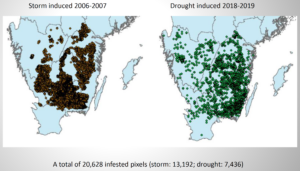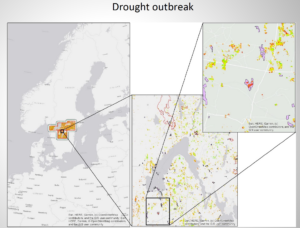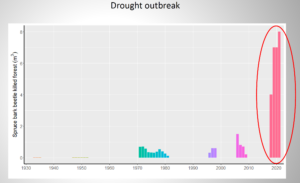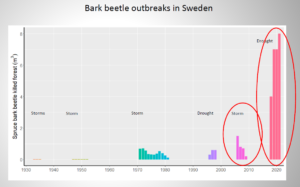New scientific paper reveals varied triggers and consequences of bark beetle disturbances in the European spruce forests.
A press release
Forests worldwide have been facing a growing threat from tree-killing bark beetles, ranking alongside droughts, wildfires, and storms as major disturbances in temperate ecosystems. In Europe, the spruce bark beetle (Ips typographus L.) has emerged as a significant forest pest, causing extensive tree mortality, particularly in Norway spruce forests (Picea abies Karst.). Recently, a group of researchers focused on forest ecology and forest disturbance, led by Dr. Simon Kärvemo, a researcher specializing in spatial ecology at the Swedish University of Agricultural Sciences, published an interesting scientific paper in the journal Forest Ecology and Management, shedding light on the bark beetle infestation patterns during storm and drought-induced outbreaks.
Key highlights of the study
The researchers analysed a total of 19,617 pixels representing one-hectare of infested spruce forest affected by windstorm and drought induced outbreaks to compare the differences in infestation occurrence and size, as well as associated forest structures and climate conditions. The study’s highlights include:
- Consistent infestation patch sizes: Both storm and drought-induced infestations showed a large proportion of small infestation patch sizes (less than or equal to 10 trees).
- Differential drivers: Storm and drought-induced infestations were influenced by different forest-condition drivers. Storm-induced outbreaks were found to be more associated with spruce volumes and area of protected forests (nature reserves), whereas drought-induced outbreaks were more linked to clear-cuts and spruce heights across spatial scales.
- Time-lagged impact of drought: The study revealed that drought-induced infestations had a time-lagged impact on infestation sizes, with soil moisture and the mean drought index (SPEI; May-July) playing crucial roles.
- Interplay between outbreaks: Interestingly, the first outbreak reduced the infestation sizes of the subsequent outbreak, likely due to the local depletion of susceptible host trees within the landscape.
The researchers, led by Dr. Kärvemo, provide a detailed exploration of the spatial configuration of bark beetle infestations, considering the factors associated with outbreaks triggered by storms and droughts. The findings have significant implications for understanding forest vulnerability and risk mapping of bark beetle outbreaks, enabling better management and mitigation strategies in the face of climate change.
In the introduction, the authors explain how drought and wind-felling are the two primary factors influencing spruce bark beetle outbreaks in Europe. Storm-induced outbreaks have historically been more common, but drought-induced outbreaks have been increasing in recent years. In 2018, an extensive drought across Europe led to the largest spruce bark beetle outbreak ever recorded, causing unprecedented tree mortality. This study marks the first large-scale comparison of factors driving infestations after storm and drought-induced outbreaks within the same region in southern Sweden.
Understanding the complexity of bark-beetle outbreaks
The study sheds light on the substantial roles that storms, droughts, and subsequent bark beetle outbreaks play in forest ecosystems. Understanding the risk factors and associated forest conditions for bark-beetle damage following different triggers is crucial for predicting outbreaks, developing risk indices, and prioritizing forest management strategies.
One key finding of the study is the considerable spatial differences in the configuration of bark beetle infestations after storms and droughts. The spatial distribution of susceptible trees emerges as a main cause for these differences. The probability and size of storm-induced infestations were found to increase with spruce volumes and the presence of nature reserves in the landscape, while the probability and size of drought-induced infestations increased with clear-cuts in the landscape and spruce heights across spatial scales.
The study also revealed an intriguing dependency between the infestation sizes of the two outbreaks. After controlling for spruce volumes, the negative relationship between infestation sizes disappeared, indicating that it was likely influenced by a local depletion of susceptible host trees or increased tree species diversity, providing dampening effect of the first outbreak.
The association between spruce volumes in the landscape and storm infestations is linked to pure stands of Norway spruce, which increase the risk of storm-felling and create higher population densities of bark beetles in these landscapes. The presence of nature reserves had contrasting effects on the two outbreaks. After the storm, the area of nature reserves in the landscape increased infestation occurrence and size, while after the drought, nature reserves showed a relatively lower risk of occurrence and no difference in infestation size. This suggests that retained trees in the landscape after a storm may attract more bark beetles and lead to larger infested patches, as well as a relatively larger risk of infestation occurrences.
The analysis also highlighted the influence of clear-cuts at both local and landscape scales on infestation occurrence and size, particularly after the drought. Clear-cut edges at local scales may act as steppingstones in the landscape for later attacks after drought-induced outbreaks.
Soil moisture played a significant role, with wetter areas reducing the occurrence of storm-induced infestations to a higher degree than drought-induced outbreaks. However, after the drought, areas with more soil moisture reduced infestation sizes to a higher degree. This indicates that drought-induced infestations were more limited in size in wetter areas, possibly due to a higher probability for bark beetle to find better host trees in nearby stands.
Implications for the future
The results emphasize the complex and multifaceted nature of bark-beetle outbreaks, with various forest variables influencing the occurrence and sizes of infestations differently for each outbreak. The findings of this study carry significant implications for predicting the infestation risks posed by the spruce bark beetle, especially as climate change continues to impact forest ecosystems, leading to an increase in bark beetle outbreaks, particularly those triggered by drought. Effective prediction of high-risk areas relies on a comprehensive understanding of the distinctions between storm and drought-induced infestations.
The study highlights the advancements in technology and the use of high-resolution satellite data, coupled with AI, to develop risk indices for bark beetle infestations. However, it also underscores the importance of tailoring such predictions to the specific outbreak trigger, as the forest stand variables and their relationships with infestations differ significantly between storms and droughts. Incorporating these variations will enhance the precision of infestation predictions and enable more targeted and effective forest management strategies.
The results further indicate that areas at high risk of experiencing large bark beetle infestation sizes, irrespective of the outbreak trigger, are typically located in dry areas with clear-cuts at a landscape scale. However, the variables influencing infestation occurrence and size varied considerably between storm and drought-induced outbreaks. The most consistent differences in risk factors for both occurrence and size of infestations were found to be associated with spruce volumes, heights, and nature reserves in the landscape. Nonetheless, the causation between nature reserves and infestations warrants further investigation, as the relationship remains uncertain.
In practical terms, when applying indices to predict future infestation risks in time and space, it is crucial to consider the underlying outbreak trigger, landscape factors, drought levels, and the impact of previous outbreak infestations. Taking these factors into account will lead to more accurate and reliable predictions, facilitating forest managers in making informed decisions to mitigate the impact of bark beetle outbreaks on forest ecosystems.
As climate change continues to influence forest dynamics and the frequency of extreme weather events, research in this field must remain ongoing to keep pace with the evolving behaviour of bark beetles and their interactions with changing environmental conditions. Understanding these complex interactions will be essential for sustaining healthy and resilient forests in the face of a changing climate.
The full text of the open access paper can be found here (doi: 10.1016/j.foreco.2023.121255). If you are interested in more details about the research, please contact Dr. Simon Kärvemo.
Please subscribe to our Instagram and YouTube channels to stay updated on the most recent advancements in the use of remote sensing methods to improve forest disturbance management and forest protection methods.
Images that could be used in the publication:
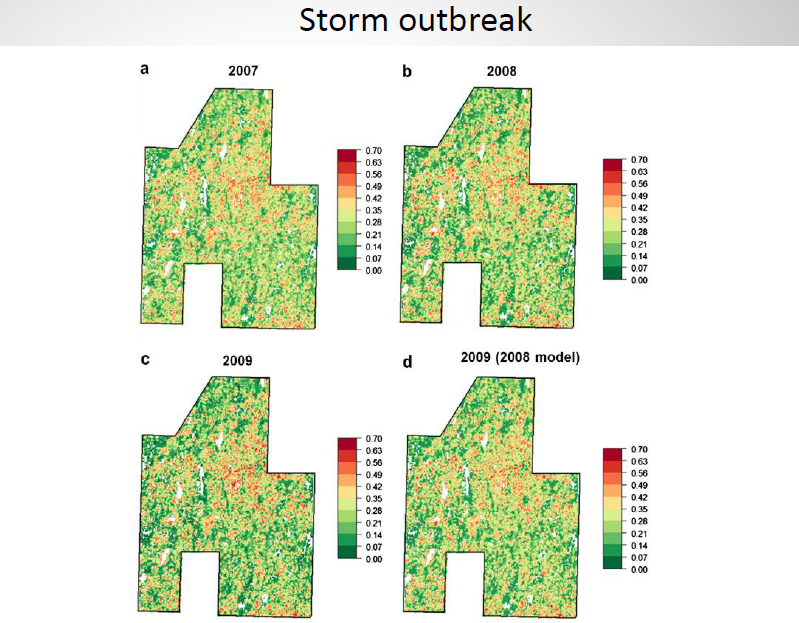
Maps of the study area showing the relative predicted risk of having at least one I. typographus infestation at 100 x 100 m resolution. The predictions are based on (a) the model of 2007, (b) the model of 2008, (c) the model of 2009, and (d), the model of 2008, which were used to predict the risks for 2009.The 2007 model only included forest-related predictors, while the 2008 and 2009 models included predictors associated with the bark beetles.
